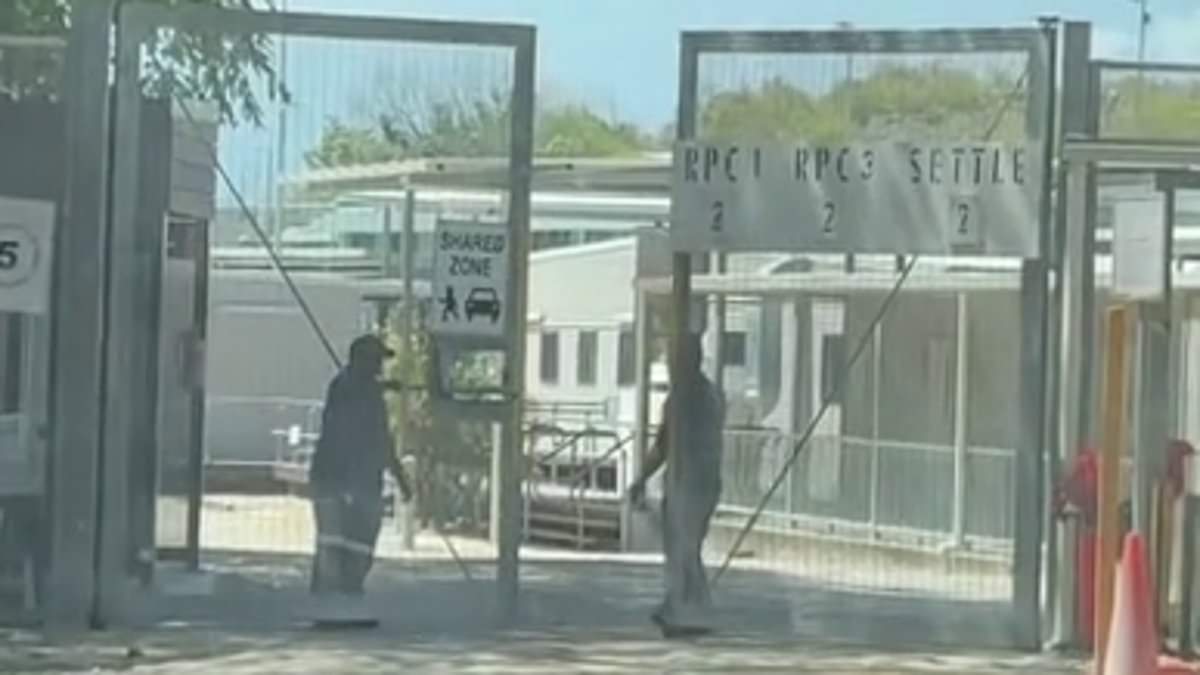A young woman filmed the moment she ‘accidentally broke into’ an offshore n immigration detention centre.
Travel blogger Chloe Jade was visiting the Micronesian island of Nauru, north-west of Papua New Guinea, with her friends on December 28.
The group decided to explore the island and were searching for an old Japanese World War II jail when they were directed towards the gates of the Nauru Regional Processing Centre – ‘s offshore immigration detention facility.
As the car approached the gates, officials questioned the group before allowing them to drive through.
‘Truly can’t believe they just opened the doors for us, asked us what was going on and let us in,’ she said in a video shared to TikTok.
‘This was not part of my intention when coming to Nauru to share about this, but we happened to get through those gates so I felt like I should share about it.’
The travel blogger explained they were asked whether they had any ‘camera gear’ when entering Nauru.
‘A lot of journalists have tried to come to the island in order to cover the situation in this place,’ Ms Jade said.
‘The conditions are said to be glum, and there are a lot of human rights violations that go on here. Apparently, they do not even issue media visas anymore.’
Social media users were shocked by how easily the woman was able to access the centre.
‘Funny they spend all the effort to keep journalists out but are letting random people with phones through the gates,’ one wrote.
Others said the detention centre had become a national disgrace.
‘As an n thank you for bringing attention to this. Nobody is talking about this anymore,’ one wrote.
A second added: ‘An absolute shame on all of us ns.’
The Nauruan government tightly controls media access to the island and the processing centre.
The cost of a media visa was drastically increased in January 2014 from $200 to $8,000 – which was non-refundable if the visa was not granted.
Since then, journalists from Al Jazeera, the ABC, SBS and the Guardian have applied for media visas but were unsuccessful.
The Nauru Regional Processing Centre is an offshore n immigration detention facility opened in 2001 under the Howard government’s pacific solution.
The centre suspended operations in 2008 to fulfil Kevin Rudd’s election promise, but was reopened in August 2012 to 2019 by the Gillard government following a large increase in asylum seekers travelling to on boat.
The detention centre was reopened once more in September 2021 and is currently in operation.
The current Coalition and Labor Party policy states all detainees attempting to reach by boat will never be settled in despite many of the asylum seekers detained on the island considered as genuine refugees.
The highest population at the centre was 1,233, detainees, including children, in August 2014, with many sent back to their country or relocated to the United States.
As of January 2025, Nauru holds more than 100 adult asylum seekers, the highest number of asylum seekers detained in over a decade, according to Amnesty International.
There have been widespread reports of detainees suffering serious human rights violations while at the facility.
The UN Special Rapporteur on Torture determined in 2015 that the offshore detention centre had systematically violated the International Convention Against Torture.
Amnesty International ‘s National Director Sam Klintworth said the policies persisted despite public outcry and legal challenges.
‘Offshore detention is a policy characterised by sheer cruelty, a dead end that has caused irreparable harm to countless people seeking safety,’ Mr Klintworth said.
‘For over a decade, people seeking refuge in have endured unimaginable suffering in Nauru, because of ‘s cruel offshore processing regime.’
‘The United Nations ruling on ‘s offshore detention regime comes as no surprise but still brings great shame.
‘The government must immediately evacuate the people held on Nauru and close the centre permanently.
‘It’s time for to honour its international obligations by immediately evacuating individuals to safety and provide safer, humane pathways to resettlement.’
